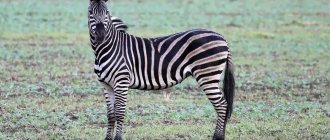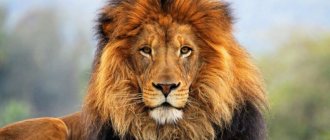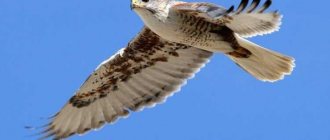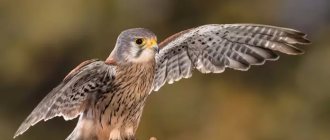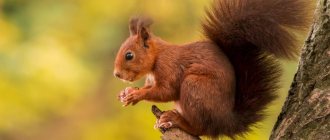The leopard is a wild predator belonging to the cat family. This graceful and agile animal is able to move quickly on land and water. The leopard has a powerful body and is larger than cheetahs, although it is inferior to them in movement speed. Living in forests and open spaces of Africa and Asia, the animal actively hunts weaker representatives of the fauna. Sometimes it attacks a person. There are other interesting facts about leopards.
With its growl and purr, the leopard is very reminiscent of a domestic cat. The exotic predator has beautiful eyes and an unusual skin color, and strong muscles are located along the entire surface of its ankles, making the animal’s legs strong. We present the most interesting facts about leopards that we managed to collect.
№1
They are well known for their habit of dragging prey up a tree, where they can quietly feast on the meat for several days. Their amazing strength allows them to drag prey into trees that is much heavier than the leopards themselves. A leopard was once recorded dragging a 125 kg baby giraffe to a height of 5.7 meters.
This behavior occurs regularly when the leopard faces competition from more aggressive predators such as lions or hyenas.
Natural enemies of the leopard
Agile, secretive and strong, adult leopards have virtually no enemies.
Their food competitors are the lion, hyena, and tiger, which can steal prey that leopards hide in the trees. In recent years, the leopard population has been steadily decreasing. The main threat to them was human activity: hunting, destruction of natural habitats, reduction of food supply. Previously, leopards were hunted for the purpose of obtaining their valuable and beautiful skins, but now poaching is associated mainly with the needs of oriental medicine. For example, at the beginning of the 21st century, the number of individuals of Far Eastern leopards was only about 50. Five subspecies of leopard, including the Far Eastern one, are included in the IUCN and Russian Red List. Hunting them is prohibited.
№3
They are carnivores, but they are not too picky when it comes to food. They hunt any animal that comes into their field of vision. In addition to gazelles and antelopes, they also hunt rodents, monkeys, snakes, large birds, amphibians, warthogs and porcupines. They also often fish in the water.
They eat approximately 1400-1800 kg of food per year.
Popular message topics
To better learn how to conserve and increase the plant and animal resources of nature, an exceptional collection has been created, which contains rare and endangered species of flora and fauna - the Red Book. Over the contents of the collection constantly
Everyone has eaten ripe and honeyed apricots, dried apricots or apricot jam at least once in their life. In Russian latitudes this is a very popular summer fruit. These delicious fruits grow on a tree that bears the same name,
Source
№5
The gestation period in females lasts about three months. There are usually two to three babies in a litter. At birth, each baby weighs about 500-600 grams. The baby is helpless, blind and has almost no fur.
The babies are completely dependent on their mother and do not leave their den until they are 3 months old. At the age of 12-18 years, they leave their mother and begin to lead an independent life. At the age of 2-3 years they are ready to give birth to their own offspring.
In the wild, the life expectancy of leopards is around 12-15 years. In captivity they can live up to 23 years.
Appearance
Depending on the place and habitat, the leopard has different sizes and coat colors. The leopard's body is long and elongated, and its legs are not very long. The jaw muscles are very well developed, as this animal has a large skull. The ears are small and round in shape. When living in warm regions, a yellow tint of coat color predominates; in dense forests, a reddish color predominates.
The leopard's chest, paws and head are covered with solid black spots, and the tail has round spots. To determine the species, each individual has its own individual coat pattern.
Leopards living in forests are larger in size than leopards living in mountainous areas. The size of the female is: weight up to 58 kg, length about 1.9 m, the weight of the male can reach 65 kg, and length up to 2.3 m.
№6
Black panthers are actually black leopards and jaguars. A cat gets its black color due to a large amount of melanin. Fur color changes are caused by genetic mutations known as melanism. It is worth noting that the animal is not completely black. If you look closely, you can see the spots characteristic of a leopard.
Many people believe that black leopards are more aggressive than regular leopards, but this is a misconception. These wild cats have exactly the same character.
Indian Leopard: Man-Eating Cat and Master of Disguise | Interesting facts about big wild cats
Greetings, dear naturalists. Zoo channel is with you. We are collecting a large video encyclopedia about all types of animals on the planet. Love nature with us, subscribe and like, they help more people learn about the animal world.
Wild big cats are everyone's favorites. Some people prefer lions, some prefer tigers, and some prefer American mountain lions, they are also cougars. There are videos about all these kind-hearted cats in the “Cats” playlist.
Well, our guest today is a master of camouflage among cats.
Meet the leopard (Panthera pardus fusca), but not a common one, but an Indian one.
In general, the leopard, also known as the leopard or panther, has several subspecies. African leopard, Indochinese leopard, Javan leopard, Indian leopard, Ceylon, North China, Far Eastern and Persian.
By the way, leopards also lived in Europe, but they became extinct relatively recently, about 10,000 years ago. Unfortunately, if people don’t come to their senses, the Indian leopard will also soon become extinct, because there are about 12 thousand individuals left in the wild, which is extremely small for the successful functioning of the population.
The biggest threat is that leos are killed for their skins, which are illegally traded in Nepal, China and India. Well, the governments of the countries where the skins of these predators are traded do not take any measures to combat poaching by banning this trade.
The Indian leopard is very similar to its African counterpart; it differs in a more contrasting fur color, and the general background of the fur is darker.
Our leo is registered in Nepal, Bhutan, Bangladesh, Pakistan, southern China and northern India. Likes to live in dry deciduous forests, tropical forests, northern coniferous forests.
The Indian leopard is one of the five big cats, because this pussy is rather big. Males have a body up to 145 cm long and a tail up to 90 cm. Weight reaches 80 kg.
All leopards, as you probably know, are excellent tree climbers. They eat their prey there, dragging the victim higher. Often it is Indian leopards that become cannibals, which is not surprising, because there are a lot of naked monkeys in India.
In the 1950s, a bloodthirsty predator ate 42 farmers in southern Karnataka. At first he attacked lonely passers-by, and then began to visit peasant farmsteads, making his way through the roof and windows to his victims. And the record for cannibalism belongs to a leopard from the Central Province of British India. He has 150 casualties to his name.
They like to quietly sneak up on potential prey or hunt from ambush. They overtake their prey in a jump, killing them with a bite to the throat or back of the head.
True, Asiatic lions and Bengal tigers pose a threat to the Indian himself, which is not surprising, because they are direct food competitors.
The Indian leopard leads a solitary, secretive lifestyle. Activity occurs at night, less often during the day. He spends most of his time in trees.
Every self-respecting Indian has his own home plot. Its average area in males is about 50 square meters. km, and for females no more than 17 square meters. km. The boundaries of hunting grounds are marked with urine and scratches on tree trunks.
Indians want love, starting from 2-3 years of age. Dating usually happens in the spring, but in the south all year round. Such a meeting of cannibals lasts a maximum of 8-9 days. After which the man waves his tail to the bride and leaves the expectant mother to raise her offspring on her own.
After 100 days, the female gives birth to 1-3 kittens in the den. The babies are born blind and helpless. Their eyes open 9-10 days after birth. At 5-6 weeks they begin to gradually switch to meat food, but milk feeding continues until 3 months. Young leopards leave their mother at the age of 13-18 months. Males transition to independent life earlier than females and move further from the maternal site.
Which of the big five cats do you like best? Lion, tiger, jaguar, leopard or puma? Write in the comments.
Become sponsors of the project for only 99 rubles per month. By doing this you will help popularize zoology, which is very important in the modern world.
Also, I draw your attention to the fact that we now have designer branded T-shirts from the channel. You can purchase them using the links in the video description.
Thank you for watching this video. Don't forget to like, write comments about what animal you would like to see in the next video, and share this video with your friends, this greatly helps the development of our small community. Subscribe to our public pages using the links in the video description, there is a lot of interesting stuff there. There was a channel about animals Zoo with you. We are collecting a large video encyclopedia about all types of animals on the planet. Love nature with us. See you soon.
№7
Very often people confuse leopards and cheetahs. In fact, they have significant differences. Firstly, cheetahs are slimmer. Secondly, cheetahs have characteristic black markings from the corner of their eyes to their mouths. Leopards do not have such markings. Third, a leopard's spots are clusters of markings, often forming circles, while a cheetah's are simply black dots.
№8
As mentioned earlier, they belong to the Panther genus. However, the African leopard is not the only species. There are also subspecies of leopards that are found throughout Asia. There are eight subspecies in total. These include:
- Indian (lives in the Indian subcontinent).
- Javanese (lives on the island of Java). This species is in danger of extinction.
- South Arabian (lives on the Arabian Peninsula). Like the Javanese, it is in danger of extinction.
- Anatolian (lives in southwestern Turkey).
- North Chinese (lives in northern China).
- Indochinese (lives in southeast Asia and Myanmar, Thailand, Malaysia).
- Ceylonese (lives exclusively on the island of Sri Lanka).
- African (lives in Africa).
Leopard distribution
— Advertising —
Leopards are common in Africa and Asia, in the north of the Caucasus Mountains and in the Amur taiga. For life they choose savannas, mixed forests and mountain slopes.
In general, these predators adapt well to any environment. So, on the African continent they live in jungles, savannas, semi-deserts and mountains. But coniferous and dense tropical and subtropical mixed forests of Asia are also becoming an acceptable habitat for them.
№9
These are very territorial individuals. Males usually occupy a larger territory than females. They mark their possessions with urine and claw marks on trees. Men are more aggressive towards members of their own sex. Women are more loyal in this regard and often share territory with a male or another female.
As for predators, leopards try to avoid areas dominated by lions, tigers or hyenas.
Popular topics today
Everyone knows about the wonderful properties of tea. But perhaps not everyone can guess where this tasty and healthy drink came from in Rus'. Long before the advent of tea, people brewed herbs, one of the most valuable
In fact, half the life of the great artist is connected with the Academy of Arts, where his parents lived, where he studied independently for twelve years. After completing the course, I followed
The tundra is located in an area with a very difficult climate for life; summer temperatures vary up to 12 degrees, and winter temperatures up to 35 degrees.
Seals are carnivorous mammals, meaning they feed their young with milk and then eat other animals.
Each of us read the famous “Sorochinskaya Fair” and watched the legendary film “Viy”. All these works of art were created by the greatest classic of Russian literature
To better study living beings, people classify them according to certain characteristics. The animal kingdom consists of organisms that range from the simplest forms to the most complex
Source
№11
They can go without water for quite a long time. However, this does not mean that they do not need water at all. When it comes to surviving in hot climates, the leopard can survive without water sources due to the fact that it draws water from its meat. Also, these wild cats may eat grass or other plants in order to replenish their body's water reserves.
We also recommend reading: Interesting facts about the black panther
Leopard story
The sun rose higher and higher above the horizon.
It illuminated everything around, the birds shook themselves and cleared their throats to sing their first song of the day, in which they glorified the sunrise and such a wonderful life. A leopard perched on a thick branch of a huge tree.
He was dozing sweetly, but the noise of the birds woke up the big cat.
The leopard stretched and slowly walked along the branch, then with a graceful leap moved to the branch of the lower tier and lay down again.
I didn’t want to move so much, the morning was cool, and a light breeze blew the leopard so pleasantly.
But hunger reminded me of itself with a rumbling in my stomach. “We’ll have to go hunting,” thought the leopard.
He stood up again and eased down from the tree. With an elastic gait, the hunter went in search of breakfast.
He noticed the zebras first; they were grazing peacefully, eating grass.
- This is a great catch, it’s just for me.
The leopard again jumped onto the tree and lay down on a branch, he hoped that some zebra would come up and he would grab it. But the zebras were not going to move towards the predator’s ambush, and the leopard again descended to the ground to look for other prey.
“I don’t like zebra meat that much,” the hunter consoled himself.
And then the leopard's attention was attracted by the giraffe. - Why not try to eat a giraffe? - he asked himself.
The leopard instantly climbed onto a higher branch and prepared to jump. But the giraffe calmly walked past the tree, slowly heading towards a clearing with green bushes.
“What is this?” the hunter thought angrily. I'll definitely have giraffe for breakfast. But then his friends approached the giraffe and the leopard pretended that he was interested in something completely different.
He jumped to the ground and went to see if there might be at least some small animal for breakfast.
He smelled the scent of a hare. - This is what I need, this one won’t leave me! The predator slowly crept, hiding in the grass.
He crawled very close to his prey and jumped, but missed. The hare darted to the side like lightning and galloped off in big leaps.
The leopard ran after the hare and tried to catch up with him.
But the hare darted towards the herd of zebras and disappeared into it. The leopard realized that he had lost, because he could not run between the zebras, who would hardly like the presence of a predator.
“Oh, it’s okay,” thought the leopard. He again went to his favorite tree.
- After all, we can have breakfast later.
More than once, a young leopard will remain hungry until he learns to really hunt.
Source
